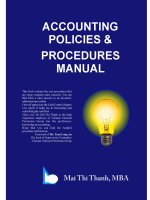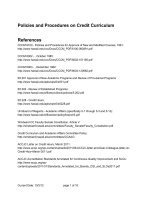Macros and procedures
Bạn đang xem bản rút gọn của tài liệu. Xem và tải ngay bản đầy đủ của tài liệu tại đây (58.87 KB, 4 trang )
6 Macros and procedures
Contents
6.1 Procedures
6.2 Macros
6.1 Procedure
Definition of procedure
A procedure is a collection of instructions to which we can direct the flow of our
program, and once the execution of these instructions is over control is given back to
the next line to process of the code which called on the procedure.
Procedures help us to create legible and easy to modify programs.
At the time of invoking a procedure the address of the next instruction of the program is
kept on the stack so that, once the flow of the program has been transferred and the
procedure is done, one can return to the next line of the original program, the one which
called the procedure.
Syntax of a Procedure
There are two types of procedures, the intrasegments, which are found on the same
segment of instructions, and the inter-segments which can be stored on different
memory segments.
When the intrasegment procedures are used, the value of IP is stored on the stack and
when the intrasegments are used the value of CS:IP is stored.
To divert the flow of a procedure (calling it), the following directive is used:
CALL NameOfTheProcedure
The part which make a procedure are:
Declaration of the procedure
Code of the procedure
Return directive
Termination of the procedure
For example, if we want a routine which adds two bytes stored in AH and AL each one,
and keep the addition in the BX register:
Adding Proc Near ; Declaration of the procedure
Mov Bx, 0 ; Content of the procedure
Mov B1, Ah
Mov Ah, 00
Add Bx, Ax
Ret ; Return directive
Add Endp ; End of procedure declaration
On the declaration the first word, Adding, corresponds to the name of out procedure,
Proc declares it as such and the word Near indicates to the MASM that the procedure is
intrasegment.
The Ret directive loads the IP address stored on the stack to return to the original
program, lastly, the Add Endp directive indicates the end of the procedure.
To declare an inter segment procedure we substitute the word Near for the word FAR.
The calling of this procedure is done the following way:
Call Adding
Macros offer a greater flexibility in programming compared to the procedures,
nonetheless, these last ones will still be used.
6.2 Macros
Contents
6.2.1 Definition of a macro
6.2.2 Syntax of a macro
6.2.3 Macro libraries
6.2.1 Definition of the macro
A macro is a group of repetitive instructions in a program which are codified only once
and can be used as many times as necessary.
The main difference between a macro and a procedure is that in the macro the passage
of parameters is possible and in the procedure it is not, this is only applicable for the
TASM - there are other programming languages which do allow it. At the moment the
macro is executed each parameter is substituted by the name or value specified at the
time of the call.
We can say then that a procedure is an extension of a determined program, while the
macro is a module with specific functions which can be used by different programs.
Another difference between a macro and a procedure is the way of calling each one, to
call a procedure the use of a directive is required, on the other hand the call of macros
is done as if it were an assembler instruction.
6.2.2 Syntax of a Macro
The parts which make a macro are:
Declaration of the macro
Code of the macro
Macro termination directive
The declaration of the macro is done the following way:
NameMacro MACRO [parameter1, parameter2...]
Even though we have the functionality of the parameters it is possible to create a macro
which does not need them.
The directive for the termination of the macro is: ENDM
An example of a macro, to place the cursor on a determined position on the screen is:
Position MACRO Row, Column
PUSH AX
PUSH BX
PUSH DX
MOV AH, 02H
MOV DH, Row
MOV DL, Column
MOV BH, 0
INT 10H
POP DX
POP BX
POP AX
ENDM
To use a macro it is only necessary to call it by its name, as if it were another assembler
instruction, since directives are no longer necessary as in the case of the procedures.
Example:
Position 8, 6
6.2.3 Macro Libraries
One of the facilities that the use of macros offers is the creation of libraries, which are
groups of macros which can be included in a program from a different file.
The creation of these libraries is very simple, we only have to write a file with all the
macros which will be needed and save it as a text file.
To call these macros it is only necessary to use the following instruction Include
NameOfTheFile, on the part of our program where we would normally write the macros,
this is, at the beginning of our program, before the declaration of the memory model.
The macros file was saved with the name of MACROS.TXT, the instruction Include
would be used the following way:
;Beginning of the program
Include MACROS.TXT
.MODEL SMALL
.DATA
;The data goes here
.CODE
Beginning:
;The code of the program is inserted here
.STACK
;The stack is defined
End beginning
;Our program ends









